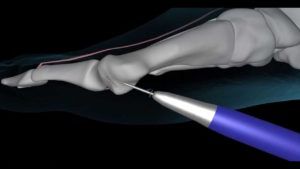
Will keyhole bunion surgery become the gold standard?
There are many surgical techniques described for bunion surgery. Despite bunion surgery having been performed for over 100 years, there has yet to be a technique that has been considered as the ‘Gold Standard’. With over 100 different operations described, Surgeons perform this procedure differently all around the world. With the recent development of keyhole bunion surgery, one must watch this space with great interest.
What is a bunion?
A bunion, also know as a ‘Hallux valgus deformity’, is a painful deformity that occurs at the base of the big toe (the 1st MTP joint). A complex mechanism results in a painful prominence forming on the inside of the great toe, and the toe itself begins to migrate towards the 2nd toe.
Normally the big toe should point forwards. When a bunion develops, the big toe drifts towards the lesser toes. When present, bunions commonly occur in both feet.

What types of bunion surgery are available?
Over the past couple of hundred years, over 100 different operations have been described for the treatment of a bunion. Foot and Ankle surgeons have continued to develop techniques aimed at restoring the normal appearance of the foot and minimising the risk of the bunion returning following the procedure.
While it is clearly not possible to explain all of the different operations in detail, there are some common techniques that may be used.

Bunionectomy
This procedure involves removing part of the metatarsal head (The bump, ‘bunion’, on the inside of the foot). However it does not address the underling biomechanics that created the bunion in the first place, and a higher recurrence rate can be expected.
Re-aligning the soft tissues around the great toe
In some cases, this procedure is added onto other procedures as part of an overall surgical plan to manage the bunion. During the development of a ‘fixed’ bunion deformity, the outer (lateral) soft tissues become contracted and tight which contributes to the abnormal positioning of the toe.
Release of these tight outer (lateral) soft tissues is often performed in conjunction with other bony re-alignment techniques outlined below.
Traditional surgical techniques usually involve an open incision over the top of the foot, between the 1st and 2nd toes to release these tissues.
When performed via a ‘keyhole’ technique, a tiny incision is used to release these tight tissues under xray guidance. No sutures are needed.
Metatarsal osteotomy
The majority of bunion surgeries involve some form of bony realignment. Surgical cuts (osteotomies) are made in the long bone of the 1st toe (metatarsal), and the bones are re-positioned to correct the abnormal angulation.
There are many different described techniques for metatarsal osteotomies, and the vast majority are performed through an ‘open’ approach to the inside of the foot.

Different fixation methods have also been employed, with most surgeons now trending towards stronger fixation techniques with the use of screws.
Originating our of Europe, recent advances in surgical technique now allow for osteotomies to be performed through keyhole techniques, minimising soft tissue scarring. Dr. Smith performs his bunion corrections using this technique.

Arthrodesis/Fusion
An Arthrodesis is a surgical procedure that ‘fuses’ one of the joints in the body. This eliminates any movement of that joint. There are several reasons why this may be performed, however in relation to foot surgery, this may be required in the setting of advanced arthritis, severe deformity, or a high recurrence rate with the use of other techniques.

There are generally two main joints that may be fused for the management of a bunion deformity.
1st MTP Joint
This is the main joint of the big toe, and is very important for propulsion during walking. Typically fusion of the 1st MTP joint is reserved for patients with severe arthritis, significant deformity, underlying inflammatory arthritis (such as rheumatoid arthritis), or another condition resulting in a high chance of recurrence with other techniques.
1st TMT Joint
This joint is part of the midfoot and represents the commencement of the metatarsal bone.
Some surgical techniques for bunion surgery involve a fusion of this joint along with a re-alignment procedure. This is typically referred to as a Lapidus procedure.
What is keyhole bunion surgery?
As with most surgical procedures, there has been a recent desire to develop minimally invasive techniques for the management of the common bunion.
There are many potential advantages with minimally invasive or keyhole surgery, including:
- Faster Recovery
- Less soft tissue scarring
- Improved cosmetic result
- Reduced pain
Keyhole bunion surgery involves the use of advanced equipment that has been specifically designed to allow for the correction of the bunion deformity via this keyhole technique. A specialised ‘Burr’ machine is used to correct the alignment of the big toe via a metatarsal osteotomy. This is done under xray guidance. Specialised small screws are used to secure the newly aligned toe into position. These screws are designed to remain inside the bone, and do not require removal in the future.


This entire procedure is performed by making 5 tiny 2-3mm incisions on the foot, and typically no sutures are required.
Following the procedure, a detailed dressing is applied to your foot.
